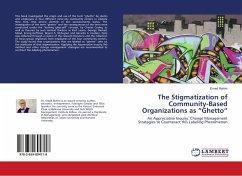This book investigated the origin and use of the term "ghetto" by clients and employees in four different inner-city community centers in Upstate New York, that service clientele of low socioeconomic status. The investigation of the term "ghetto" and the consequences of the term were conducted under the "looking glass-self" concept, by Charles Cooley, as well as theories by such seminal thinkers as Kurt Lewin, George Herbert Mead, Erving Goffman, Bryant A. Okhuysen and Gerardo A. Hudson. Data was collected through a review of the relevant literature and the collection of focus group responses from employees of the four community centers. The study found that organizations that are labeled as "ghetto" take on the attributes of that stigmatization. Applying the Appreciative Inquiry (AI) method and other change management strategies are recommended to confront this labeling phenomenon.
Bitte wählen Sie Ihr Anliegen aus.
Rechnungen
Retourenschein anfordern
Bestellstatus
Storno








